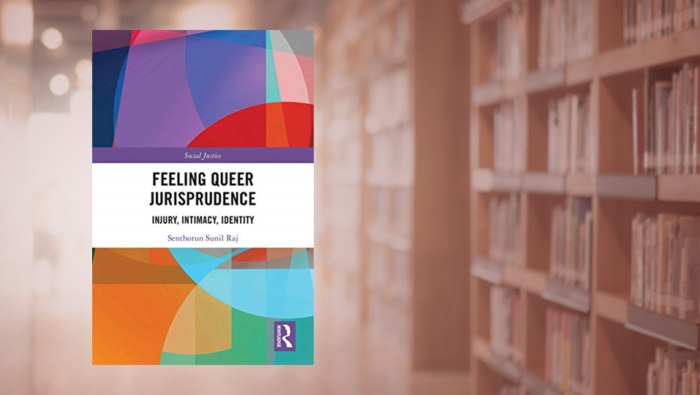
Decoding the Affective Life of Law

In Feeling Queer Jurisprudence, Senthorun Raj interrogates the role played by emotions (understood as the discursive construction of affect) in a range of UK, US and Australian cases dealing with LGBT issues – from (de)criminalisation and (anti)discrimination, through hate crime and asylum seeking, to marriage. A fairly precise rendition of the book’s research question might be: ‘How do British, US, and Australian courts rhetorically deploy disgust, hate, anger, fear and love in cases that, even when advancing LGBT rights, do so at the cost of either obscuring or de-legitimising less mainstream queer experiences, or oversimplifying the social determinants of discrimination?’
This formulation makes it clear that Feeling Queer Jurisprudence is firmly located within a tradition of queer scholarly thought (much of which is deftly surveyed in Chapter 1) that concerns itself with the marginal and anti-normative. Yet Raj’s book also manages to maintain a nuanced position that acknowledges LGBT legal successes as gains, if not unqualified goods. It is, arguably, precisely Raj’s focus on emotions that enables him to handle this complexity in a satisfying way: after all, LGBT-affirming decisions can do valuable affective work even when their practical implications are more mixed. The originality of Raj’s book is precisely in its analytical use of emotions to navigate and make sense of the tension between LGBT normative gains and queer anti-normative allegiances.
Chapter 2 shows how pervasively disgust has featured between the late 19th and late 20th century in justifying such phobic outcomes as the conviction of Oscar Wilde, the constitutionality of US sodomy laws (Bowers v Hardwick), and the homosexual advance defence (Green v R). Less indiscriminate, yet highly problematic, deployments of this emotion were on display in the Wolfenden report and in R v Brown, singling out, respectively, public and sadomasochistic queer sex for special censure.
Chapter 3 addresses US cases involving transphobic and homophobic hate, including Nebraska v Lotter. Raj shows how progressive judicial and law-reform discourses, in turning hate against the haters themselves (that is, in condemning the perpetrators of LGBT violence), have the effect of obscuring the structural conditions that make such violence thinkable and doable, including the Courts’ own role in de-authorising trans experiences. This chapter particularly resonated with me: in calling the reader’s attention to the entanglements between homophobia and transphobia, it indirectly speaks to the vacuity of recent ‘LGB without the T’ political engagements (whose academic counterpart I critiqued elsewhere).
Chapter 4 discusses US and Australian cases concerning anti-LGBT discrimination, including ones motivated by religious beliefs. It argues that while anger at discrimination can galvanise positive legal change, if not adequately managed in judicial decision-making it may also have negative implications. These include obscuring intersectional queer experiences (such as those of religious queers in Christian Youth Camps Ltd v Cobaw Community Health Services Ltd), and denying ‘indiscreet’ queer folks the benefits of anti-discrimination law (as in Dale v Boy Scouts of America).
Until fairly recently LGBT asylum seekers in UK and Australia were also told that they could avoid persecution in their home-countries by being ‘discreet’. Chapter 5 argues that in imposing this demand, refugee law ignored that queer discretion tends to come from a place of fear. Furthermore, this self-same emotion is also salient to refugee law’s own treatment of queer asylum seekers: decision-makers’ fear of being overrun by foreigners intensifies their preoccupation with establishing the authenticity of claimants’ claims to their sexual and gender identities.
Finally, Chapter 6 turns to same-sex marriage. The arguments echo familiar queer critiques, yet Raj’s analysis is particularly insightful in showing how the invocation of a rhetoric of love in US judicial discourse (United States v Windsor and Obergefell v Hodges) de-authorises non-heteronormative intimacy and relationality.
The choice to concentrate purely on Western jurisdictions (all of them common law ones, except for a cameo role reserved for the European Court of Justice) enables Raj to construct a cohesive and self-contained narrative, permitting him to suspend a consideration of some fraught questions that a more expansive focus on LGBT rights and politics in the Global South would demand. Yet, Raj has already addressed some of those questions in his articles, and perhaps a book-length treatment is in the cards? Whatever Raj’s next endeavour, after reading Feeling Queer Jurisprudence, I think you will join me in looking forward to it.

